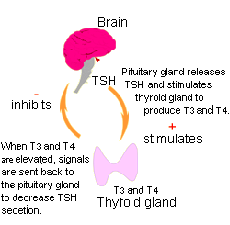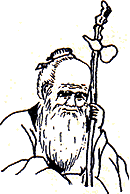|
Hyperthyroidism, also referred to as thyrotoxicosis, is a condition that results from over-activity of the thyroid gland and consequent excess of circulating thyroid hormones in the body. Thyroid hormones have a direct effect on most organs and cells of the body. They essentially regulate metabolism and growth, and the symptoms of their excess are diverse.
The condition is common, especially in women, and usually occurs in those between the ages of 20 and 50 years. Hyperthyroidism is diagnosed in two per cent of women and is seen five to 10 times less frequently in men.
The thyroid gland consists of two lobes of soft glandular tissue joined by a narrow segment called the isthmus. The lobes lie either side of the trachea (windpipe) in the lower neck and in the normal thyroid measure up to 4 cm in length and weigh 15 to 20 g. They are well supplied with blood vessels.
Thyroid tissue is composed of vast quantities of sac-like follicles (small secretory cavities). These produce and store the thyroid hormones thyroxine (T4) and triiodothyronine (T3). The hormones circulate in the blood plasma largely bound to transport proteins. Production of T3 and T4 is controlled by the thyroid stimulating hormone (TSH), which is secreted by the pituitary gland in the brain, and is dependent on an adequate intake of iodine in the diet.
 |
| Normal thyroid hormone control |
|
| |
|
| |
| Hyperthyroidism is a condition in which overproduction of thyroid hormone results in metabolic imbalance. The syndrome describes the signs and symptoms that result from an excess of circulating hormone. Graves' disease is the most common cause of hyperthyroidism. It is an autoimmune disease of the thyroid gland and presents with anxiety, a rapid heartbeat, sweating, increased appetite with weight loss, fine tremor of the extended hand and prominence of the eyes. The condition is more commonly found in women than men, in the ratio of 4:1, and is usually seen in the age group 20 to 40 years.
From a traditional Chinese medicine (TCM) viewpoint, hyperthyroidism is categorized as a "goiter." This is defined as a mass protruding over the area of the neck with localized redness; the mass may also be pendent and attached to the neck by a short stalk. This definition is similar to that of Western medicine.
TCM physicians believe that an improper diet and emotional problems, such as anxiety or anger, lead to stagnation of qi in the liver and spleen. This gives rise to accumulation of vital energy (qi) and phlegm in localized areas and facilitates the formation of a mass. The history of thyroid disease in TCM is long. It can be traced from as early as the Sui dynasty (581-618 AD) and is mentioned in the medical classic Zhubing Yuanhoulun (Treatise on the Causes and Symptoms of Diseases). Sun Simao (581-682 AD), one of the most influential physicians in the history of Chinese medicine, is renowned for his treatment of the disease. He recognized that hyperthyroidism arose from drinking water in certain mountain regions, and he also used the thyroid glands from deer and sheep, which have a high iodine content, to treat the disease.
 |
| Sun Simao (581-682 AD) |
|
| |
|